  |
The Battle for Warsaw During the Polish Campaign
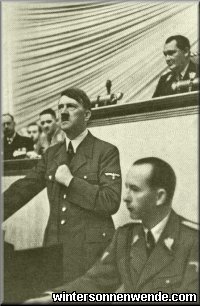
The Führer
in his Sept. 1, 1939 address to the Reichstag.
"Therefore I have decided that from now on we will speak to Poland in the same language as they have been using towards us for months!"
|
During the memorable Reichstag session of September 1, 1939, the Führer's historic speech culminated in the sentence:
"Therefore I have decided that from now on we will speak to Poland in the same language as they have been using towards us for months. As of 5:45, we are shooting back!"
A few weeks later, the Military Communiqué of September 26, 1939 reported that military actions against Warsaw had commenced. On September 27, the Communiqué read:
"The force of the German attacks has persuaded the Polish Commandant to offer the surrender of the city and its garrison this morning."
In a military retrospective, the Chief of the Wehrmacht Supreme Command, then General Keitel, summarized the events of the Polish Campaign as follows:
"The chief aim of the German ground forces was to launch a comprehensive attack on the several units of the Polish army while still west of the Vistula, to engage them in battle and to wipe them out. West of the Vistula, particularly on the Tucheler Moors, near Radom, and in the Vistula bend north-east of Kutno, a series of devastating battles took place, in the course of which the Polish army was utterly defeated. The campaign reached its last high point and military conclusion with the collapse of the fortresses of Warsaw and Modlin."
These few brief sentences chronicle the great events of the Polish Campaign.
Many are the cities, towns and rivers fought for at that time, in the battles for which the young National-Socialist Wehrmacht earned its first victor's laurels. Yet still, the name that informs all the events of those September days is "Warsaw", the capital of the Polish state, which had to be conquered before the triumphal march was complete.
It is therefore perfectly understandable that the fighting was particularly bitter in the District of Warsaw. The great battle on the River Bzura, the battle on the Vistula bend, the bombardment and capture of Warsaw
itself – those were the decisive events of the final stage of the Polish Campaign.
In the eastern part of the District, troops moving south out of East Prussia had already crossed the Narew River on September 7, 1939, and had beaten the enemy back behind the River Bug at Wyszkow north of Warsaw. Shortly after, they gained a foothold on the southern bank of the Bug and sealed Warsaw off on the east by means of further southward advance. Thus, the road and railway line running between Warsaw and Siedlce was reached and crossed. All Polish attempts to break out of the District of Praga were repulsed.
Bitter battles took place west of Warsaw as well. Before the very city gates, German forces that had advanced into this area prevented the Polish armies deployed in the region of Posen and the Corridor from retreating behind the Vistula. In the region between Kutno, Skierniewice and Sochaczew, approximately a quarter of the entire Polish army was encircled by the German troops penetrating the area from the west, north and south. The Polish troops, putting up a desperate defense, made several attempts to break out in the south and south-east, in the vicinity of Lowitsch [now called Lowicz], but all their efforts came to nought against the resistance of the German troops, which drew their circle ever tighter around them.
On September 19, 1939, the Wehrmacht Supreme Command reported the end of the "Battle of the Bzura", and added, on September 20, that this battle, which had lasted for about a week, had been one of the most devastating of all time. The Polish army of 170,000, which had been encircled there, had surrendered.
With that, Warsaw was completely surrounded, and the German Command therefore demanded the surrender of the city. But even though the military situation was perfectly clear, the Polish Commandant's answer was a curt refusal, and even the German Command's humanitarian suggestion, that at least Warsaw's civilian population be permitted to leave the city via two roads designated for that purpose, was rejected. Instead, the Polish Commandant ordered that the civilian populace, together with the Polish troops 120,000 strong, would defend the city to the last. Only the Diplomatic Corps and 1,200 other foreigners were permitted to leave Warsaw, and they did so on September 21 via the road to Bialystok. Then the final battle for Warsaw began with that historic bombardment that sealed Poland's fate.
When encircled troops put up heroic resistance against overwhelming opposing forces and defend themselves tenaciously to the last man, or when a fortress surrounded by the enemy resists defeat to the bitter end, there is a point to this. We Germans, perhaps more than anyone else, respect a brave opponent. The defense of Warsaw, however, was not a deed of heroism but rather an act of insanity. The Commandant of Warsaw, Polish General Rommel, ought to have acknowledged to himself that with a population of over a million, cut off as they were from all incoming supplies and hence in imminent danger of starvation, he could defend Warsaw for a few days at the most, but that in light of the complete annihilation of the Polish army which had already come about on all other battle fronts, doing so would not decisively influence the outcome of the conflict in any way.
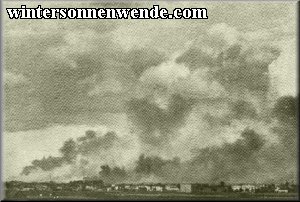
German artillery fire envelops Warsaw. Under its cover, German infantry advances towards Warsaw.

|
And so weapons had to speak instead, and their language was quite plain. Anyone who witnessed the bombardment of Warsaw by the batteries set up around the entire city, and by the German pilots' incessant air raids, will find those days imprinted indelibly in his memory. Hundreds of artillery guns hurled their grenades into Warsaw, where every nook and cranny was soon on fire. In between, German fighter planes dropped their bombs on the city, which was very soon canopied by a tremendous cloud of fire and smoke.
The barrage reached its peak on September 25 and 26, 1939. The black clouds that enveloped Warsaw at that time rose thousands of meters into the sky. Every now and then, munition stores blew up, gasworks were hit, and fires flared up everywhere, so that at night a mighty red glow of fire
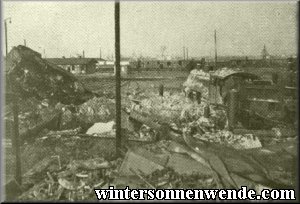
Wrecked train station facilities in Warsaw.
Wrecked engine-sheds of the Warsaw train station.

|
emanated from Warsaw and could be seen well over 100 km away.
During this time, Warsaw was hell on Earth. The ethnic Germans who spent those days in Warsaw later reported what the city's inhabitants had had to endure. Food supplies had been used up, so that hunger was great everywhere. Hundreds of houses collapsed, and many who had crowded into the basements for protection thus lost their lives. Entire city districts were on fire, and the destruction of the watermains made any fire-fighting operations impossible. And on top of it all, time and again, came the wail of German grenades and the crash of German bombs which smashed into the city without respite.
September 26, 4:00 o'clock in the morning, saw the storming of Fort Mokotow, during which the 51st infantry regiment particularly distinguished itself. The two company commanders, First Lieutenant Steinhardt and Second Lieutenant Stolz, were the first officers of the German Wehrmacht to receive the Knight's Cross
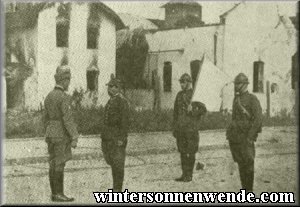
The arrival of the Polish negotiators.
Negotiating the terms of surrender
in the van of the Army Supreme Command.
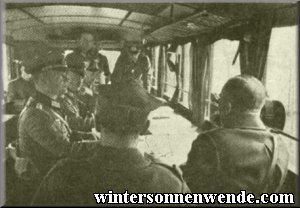
|
in addition to the Iron Cross. Both were later killed in action during the Russian Campaign. Since most of the other forts were also defeated that day, the circle around Warsaw grew ever tighter.
On September 27, at 4:30 in the morning, the bombardment was intensified, and finally brought the Poles to their senses. At 9:29 a.m., a Polish envoy dispatched by the City Commandant of Warsaw arrived and requested an armistice.
With military brevity, General von Blaskowitz – chosen for the task by the
Commander-in-Chief of the Army – negotiated the terms of surrender.
With this capitulation of Warsaw, the Polish Campaign had been brought to a victorious conclusion.
The only task left now was to disarm the 110,000-strong Polish troops in Warsaw, and to occupy the city.
   Warsaw Under German Rule
Warsaw Under German Rule
German Reconstruction and Development in the District of Warsaw
|
|